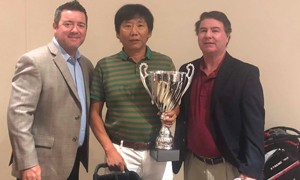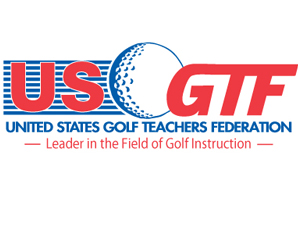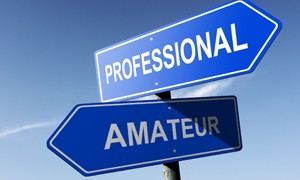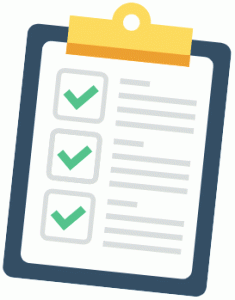Max Faulkner Returns Claret Jug to the British Isles
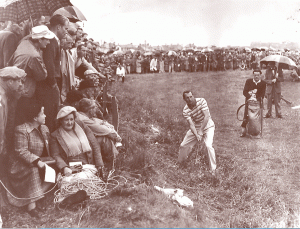 By Mike Stevens, USGTF Teaching Professional Tampa, Florida
By Mike Stevens, USGTF Teaching Professional Tampa, Florida
In 1951 the Open Championship was played outside Great Britain for the first time. The site was Royal Portrush in Northern Ireland, which hosts once again this year. I could not find a reason for going there other than it is a beautiful course with magnificent landscape. I guess the R&A just wanted a change of pace.
The odds-on favorite going in was defending champion Bobby Locke of South Africa. Max Faulkner, the eventual winner, on the other hand was a decent player with a few minor tournament victories in England. Born on England’s south coast in 1916, he was introduced to the game by his father Gus, a former assistant to the great James Braid. Max was a multisport talent, but golf seemed to be his favorite pastime. He joined his dad as an assistant pro after his schooling and started getting some notoriety as a potential player until the big one began. From 1939 to 1945, he played exactly two rounds of golf while serving his country in defeating the German war machine.
Once peace returned, Faulkner went back to work on his game, which came back quickly, but what he was most noted for was his dashing attire in bold colors and cheerful disposition. Entering the ’51 Open, he had a good feeling about his chances. He played Portrush in the Irish Open at21, finishing third, and felt it favored his power fade as most of the holes have a right-hand curve. He al so believed a very light putter, one of the many he owned, would come in handy on the fastest greens of all Open venues. His premonition was correct, needing only 51 putts with the magic wand in the first two rounds to top the leaderboard with a score of 141. The final two rounds of the Open in those days were played on the same day, and Max, playing well in the morning round, came to the 16th hole well in the lead, but hit a disastrous drive that landed within two feet of a barbed-wire boundary fence. But Max believed it was his day. Rather than chip out, he took his 4-wood and with his backside against the barbs, he abruptly cut the ball out over the OB fence, curving the ball on to the putting surface. His playing partner, American Frank Stranahan, walked over and commented to him that it was the finest shot he had ever seen. Faulkner would finish the third round six shots clear of the field.
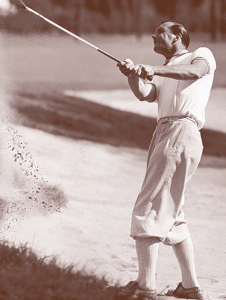 Here is where the story gets even more interesting. After a brief respite, Max headed for the first tee. As he walked, a young boy approached and asked him to sign a ball, but Faulkner was reluctant, not wanting to be distracted. Then the boy said, “You’re going to win,” and at the urging of the boy’s father who mentioned how much it would mean to the boy, Max signed the ball – Max Faulkner, Open Champion 1951. For the first time, he let the thought of blowing a big lead enter his mind, and struggled a bit coming home in 74. There were no scoreboards at the time, so runners were dispatched to and from to let people know what was going on with players still on the course. Word came in that Tony Cerda had turned in 34 and was a threat to catch the leader. A bit later, the word was that three fours on the final holes would tie Faulkner. A final messenger approached Max and related to him, “Cerda’s taken six; it’s your Open.”His dream had proved true – he was the Champion Golfer of the Year. The Claret Jug held by South African Bobby Locke would be returning to Britain.
Here is where the story gets even more interesting. After a brief respite, Max headed for the first tee. As he walked, a young boy approached and asked him to sign a ball, but Faulkner was reluctant, not wanting to be distracted. Then the boy said, “You’re going to win,” and at the urging of the boy’s father who mentioned how much it would mean to the boy, Max signed the ball – Max Faulkner, Open Champion 1951. For the first time, he let the thought of blowing a big lead enter his mind, and struggled a bit coming home in 74. There were no scoreboards at the time, so runners were dispatched to and from to let people know what was going on with players still on the course. Word came in that Tony Cerda had turned in 34 and was a threat to catch the leader. A bit later, the word was that three fours on the final holes would tie Faulkner. A final messenger approached Max and related to him, “Cerda’s taken six; it’s your Open.”His dream had proved true – he was the Champion Golfer of the Year. The Claret Jug held by South African Bobby Locke would be returning to Britain.
Max Faulkner would go on to win 16 tournaments in Europe, but never another Open Championship. It was his crowning achievement and all he ever wanted. He also played on five Ryder Cup teams, including the surprise 1957 team in which Britain won for the first time since 1933.
Another interesting chapter in his life came in1973 during the Open at Troon. He was paired with Gene Sarazen when Sarazen recorded a hole-in-one at the famed Postage Stamp. It was Sarazen and Walter Hagen who were models for Faulkner’s snappy attire on the golf course.
Max Faulkner played for six decades, observing golf from the hickory era to the many changes in ball and club technology. A true sportsman, he could have played professionally at tennis, cricket or soccer, but golf was his true love. On the 50thanniversary of his triumph in the Open, he was honored with the Order of the British Empire for his service to golf. He lived out his remaining years in Sussex and passed away in 2005 after contracting pneumonia at the age of 88, a true gentleman of the game who should not be forgotten.


 Of all the places that the United States Golf Teachers Cup has been played in its previous 23 years, it would be difficult to say that there was a more beautiful setting than the 2019 edition featured. Sedona, Arizona, was the venue for the 24th playing of the USGTF’s national championship event, held this past October at Oakcreek Country Club. Participants from all over the
country and several international competitors teed it up at the Robert Trent Jones design.
Shouting (Hunter) Huang, from Atlanta, Georgia, staged an incredible rally the final day to win the U.S. Cup for the first time, overtaking first-round leader and seven-time champion Mark Harman with a brilliant final nine-hole score of 31, allowing him to edge runner-up Jose Esteves of uerto Rico by two shots. Huang finished with scores of 75-68 – 143 in taking down top honors.
Most of the field struggled to put a good score on the board the first day, with Harman leading the pack at 74. Huang and Esteves, along with Costa Rica’s Alejandro Duque, were a stroke back at 75.
“I got off to a slow start as I was three over for the first three holes,” remarked Harman. “When my 74 held up for the lead, I was surprised as the field was strong and the course was there for the taking.”
Duque fired a strong 34 on the outward nine the second day to forge into the lead at +1 for the tournament, a stroke ahead of both Esteves and Harman. Huang shot a pedestrian 37 and was three strokes behind, and although he birdied the par- 5 10th hole, so did his three closest competitors.Esteves made the first move when he also birdied the 11th and 12th holes and parred the 13th, taking a two-shot lead over Harman, and led Duque and Huang by four. It looked all but over for the latter two, but Huang had other ideas. Starting on the 14th hole, Huang ripped off his own birdie barrage with four in a row while each of his closest pursuers all had a double bogey during that stretch.
By the time he got to the 18th hole, Huang, playing with Esteves, had a two-shot lead over the eventual runner-up in a stunning turn of events. Starting on the 14th hole and ending on the 17th, Huang outscored Esteves and Harman by six strokes, and Duque by five. It was a display of golf that is sure to become legendary in U.S. Cup lore. “It was incredible to watch,” said Esteves. Duque wound up in third while Harman faded to fourth.
Huang’s victory capped off a fine season of play in USGTF events. He also won the USGTF Central Region Championship in August, becoming the first in USGTF history to win both a region championship and the U.S. Cup title in the same year.
Richards thwarts Gulych’s attempt at three-peat
Grant Gulych from St. Thomas, Ontario, had a chokehold on the United States Senior Golf Teachers Cup, winning the first two titles in an event that was inaugurated in 2017. With his experience and playing resume, Gulych was one of the favorites to win and certainly was in strong position after a first-round 71.
However, complicating the matter for Gulychand the other competitors was the presence of Christopher Richards from Trinidad & Tobago, making his first appearance at the U.S. Senor Cup. Richards also had a formidable resume that included winning the individual 2007 World Golf Teachers Cup championship and the 2010 U.S. Cup. Richards fired a first-round 70 that could have been so much better, but the Oakcreek course proved to be a tricky opponent for Richards. The Trinidadian managed to make six birdies, but two bogeys and a double bogey derailed what could have been a special round. Canada’s Dave Belling, a two-time U.S. Cup champion and individual 2003 World Golf Teachers Cup champion, lurked two strokes off the pace at 72, followed by Steve Simer at 73 and Michael Wolf at 75.
Playing together in the final round, Richards and Gulych both went out in even-par 36 while Belling was at 37. Simer and Wolf both failed to break 40 and no longer posed a threat. The contest was still close after 12 with Richards clinging to a one-shot lead when he engaged in fireworks of his own. A birdie on #13, followed by an eagle on the drivable par-4 14th staked Richards out to a three-shot lead over Gulych, and that effectively was the turning point. Gulych managed to cut the lead to one shot entering the final hole, but a bogey there ended his chances. Richards carefully two-putted from short range for his own bogey, sealing the deal. He finished with scores of 70-70 – 140, while Gulych’s strong defense of his title fell just short at 71-70 – 141. Belling wound up third at 72-70 – 142.
The Super Senior division of the U.S. Senior Cup was closely fought as John McGaugh from Calimesa, California, overcame first-round leader Daniel Lee from Kenmore, Washington, to win by two strokes with scores of 77-73 – 150. A four-way tie at 155 by Jim Perez, Ken Butler, Bruce Sims and Vito Cisternino highlighted the strength of the 60-and-over crowd. All were eligible for overall U.S. Senior Cup honors as their division played from the same tees as did the Senior division.
Longtime competitor Pat Church from Eugene, Oregon, and a USGTF Hall of Fame member, captured her first Ladies division title. Gary Focken from The Villages, Florida, fired scores of 78-74 – 152 to defeat runner-up Jim Peters from Newport, Kentucky, by five shots in the Legends division.
For the first time ever, a concurrent pro-am was contested in conjunction with the U.S. and U.S. Senior Cups. Players were invited to bring an amateur partner with them and compete in the same format that is conducted at Pebble Beach every year on the PGA Tour. Seventeen teams teed it up as the amateurs got to see their professional partners up close in a national championship professional event. A clinic was held after the first round, conducted by Wolf and Gulych.
Duque and his amateur partner Diengo Chou fired a two-round total of 129 in a fourball format that included the professional playing at scratch and amateur receiving 80 percent of their course handicaps. Focken and his amateur partner Terry Edwards also shot a 129, but lost in the tiebreaking procedure where the professional’s score in the final round determined the winner. Steve Fine and his amateur partner Cliff Armstrong finished third at 133.
Oakcreek Country Club was in outstanding shape and may well have been the best-conditioned course in the 24-year history of the United States Golf Teachers Cup. The bentgrass greens rolled fast and true, and the fairways were green and lush. Redtinged sand bunkers that contrasted with the hue of the grass, along with well-placed and well-maintained ponds, completed the aesthetically pleasing aspects of the course. Sedona itself is one of the USA’s mostvisited tourist locations with almost three million visitors finding the time to make the worthwhile trek to northern Arizona’s incredible scenery. Sedona features spectacular red rock formations and a high desert climate, creating a stunning beauty that many wll never forget for the rest of their lives. It was certainly a venue that lived up to its billing, and all participants who weighed in said it was one of the most enjoyable places they’ve ever played.
Of all the places that the United States Golf Teachers Cup has been played in its previous 23 years, it would be difficult to say that there was a more beautiful setting than the 2019 edition featured. Sedona, Arizona, was the venue for the 24th playing of the USGTF’s national championship event, held this past October at Oakcreek Country Club. Participants from all over the
country and several international competitors teed it up at the Robert Trent Jones design.
Shouting (Hunter) Huang, from Atlanta, Georgia, staged an incredible rally the final day to win the U.S. Cup for the first time, overtaking first-round leader and seven-time champion Mark Harman with a brilliant final nine-hole score of 31, allowing him to edge runner-up Jose Esteves of uerto Rico by two shots. Huang finished with scores of 75-68 – 143 in taking down top honors.
Most of the field struggled to put a good score on the board the first day, with Harman leading the pack at 74. Huang and Esteves, along with Costa Rica’s Alejandro Duque, were a stroke back at 75.
“I got off to a slow start as I was three over for the first three holes,” remarked Harman. “When my 74 held up for the lead, I was surprised as the field was strong and the course was there for the taking.”
Duque fired a strong 34 on the outward nine the second day to forge into the lead at +1 for the tournament, a stroke ahead of both Esteves and Harman. Huang shot a pedestrian 37 and was three strokes behind, and although he birdied the par- 5 10th hole, so did his three closest competitors.Esteves made the first move when he also birdied the 11th and 12th holes and parred the 13th, taking a two-shot lead over Harman, and led Duque and Huang by four. It looked all but over for the latter two, but Huang had other ideas. Starting on the 14th hole, Huang ripped off his own birdie barrage with four in a row while each of his closest pursuers all had a double bogey during that stretch.
By the time he got to the 18th hole, Huang, playing with Esteves, had a two-shot lead over the eventual runner-up in a stunning turn of events. Starting on the 14th hole and ending on the 17th, Huang outscored Esteves and Harman by six strokes, and Duque by five. It was a display of golf that is sure to become legendary in U.S. Cup lore. “It was incredible to watch,” said Esteves. Duque wound up in third while Harman faded to fourth.
Huang’s victory capped off a fine season of play in USGTF events. He also won the USGTF Central Region Championship in August, becoming the first in USGTF history to win both a region championship and the U.S. Cup title in the same year.
Richards thwarts Gulych’s attempt at three-peat
Grant Gulych from St. Thomas, Ontario, had a chokehold on the United States Senior Golf Teachers Cup, winning the first two titles in an event that was inaugurated in 2017. With his experience and playing resume, Gulych was one of the favorites to win and certainly was in strong position after a first-round 71.
However, complicating the matter for Gulychand the other competitors was the presence of Christopher Richards from Trinidad & Tobago, making his first appearance at the U.S. Senor Cup. Richards also had a formidable resume that included winning the individual 2007 World Golf Teachers Cup championship and the 2010 U.S. Cup. Richards fired a first-round 70 that could have been so much better, but the Oakcreek course proved to be a tricky opponent for Richards. The Trinidadian managed to make six birdies, but two bogeys and a double bogey derailed what could have been a special round. Canada’s Dave Belling, a two-time U.S. Cup champion and individual 2003 World Golf Teachers Cup champion, lurked two strokes off the pace at 72, followed by Steve Simer at 73 and Michael Wolf at 75.
Playing together in the final round, Richards and Gulych both went out in even-par 36 while Belling was at 37. Simer and Wolf both failed to break 40 and no longer posed a threat. The contest was still close after 12 with Richards clinging to a one-shot lead when he engaged in fireworks of his own. A birdie on #13, followed by an eagle on the drivable par-4 14th staked Richards out to a three-shot lead over Gulych, and that effectively was the turning point. Gulych managed to cut the lead to one shot entering the final hole, but a bogey there ended his chances. Richards carefully two-putted from short range for his own bogey, sealing the deal. He finished with scores of 70-70 – 140, while Gulych’s strong defense of his title fell just short at 71-70 – 141. Belling wound up third at 72-70 – 142.
The Super Senior division of the U.S. Senior Cup was closely fought as John McGaugh from Calimesa, California, overcame first-round leader Daniel Lee from Kenmore, Washington, to win by two strokes with scores of 77-73 – 150. A four-way tie at 155 by Jim Perez, Ken Butler, Bruce Sims and Vito Cisternino highlighted the strength of the 60-and-over crowd. All were eligible for overall U.S. Senior Cup honors as their division played from the same tees as did the Senior division.
Longtime competitor Pat Church from Eugene, Oregon, and a USGTF Hall of Fame member, captured her first Ladies division title. Gary Focken from The Villages, Florida, fired scores of 78-74 – 152 to defeat runner-up Jim Peters from Newport, Kentucky, by five shots in the Legends division.
For the first time ever, a concurrent pro-am was contested in conjunction with the U.S. and U.S. Senior Cups. Players were invited to bring an amateur partner with them and compete in the same format that is conducted at Pebble Beach every year on the PGA Tour. Seventeen teams teed it up as the amateurs got to see their professional partners up close in a national championship professional event. A clinic was held after the first round, conducted by Wolf and Gulych.
Duque and his amateur partner Diengo Chou fired a two-round total of 129 in a fourball format that included the professional playing at scratch and amateur receiving 80 percent of their course handicaps. Focken and his amateur partner Terry Edwards also shot a 129, but lost in the tiebreaking procedure where the professional’s score in the final round determined the winner. Steve Fine and his amateur partner Cliff Armstrong finished third at 133.
Oakcreek Country Club was in outstanding shape and may well have been the best-conditioned course in the 24-year history of the United States Golf Teachers Cup. The bentgrass greens rolled fast and true, and the fairways were green and lush. Redtinged sand bunkers that contrasted with the hue of the grass, along with well-placed and well-maintained ponds, completed the aesthetically pleasing aspects of the course. Sedona itself is one of the USA’s mostvisited tourist locations with almost three million visitors finding the time to make the worthwhile trek to northern Arizona’s incredible scenery. Sedona features spectacular red rock formations and a high desert climate, creating a stunning beauty that many wll never forget for the rest of their lives. It was certainly a venue that lived up to its billing, and all participants who weighed in said it was one of the most enjoyable places they’ve ever played.

